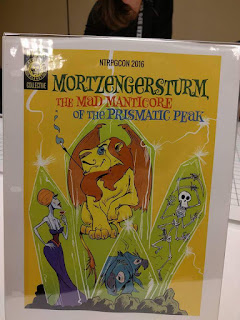There's been a bit of discussion on Google+ about Oz-influenced D&D. From its conception, Oz has been an important (though certainly not the only) influence on the
Land of Azurth (particularly for the primary campaign site, Yanth Country), so I've thought some about how Ozian elements can be used to inform D&D fantasy.
First off, it must be aknowledged that "Ozian fantasy" may not be a precisely defined thing. The portrayal of Oz itself changes from the first book to later books by Baum--and to an even greater degree throughout the "
Famous Forty" and beyond. Oz in the
The Wonderful Wizard of Oz is mostly uninhabited, and the places that are inhabited are mostly agrarian, but later books pile on more and more civilization. Baum's vision is of an American fairytale, and so the early books lack standard European-derived or Arabian Nights-inspired creatures and characters: The Tin Man is a
woodsman not a
knight. Ultimately, however, knights, dragons, and genies all become part of Oz.
(Anyone interested in Baum's American fairytale conception and examples of it in his non-Oz fantasies should check out
Oz & Beyond: The Fantasy World of L. Frank Baum by Michael O. Riley)
With that sort of lack of specificity in mind, here are my broad suggestions for how to make a D&D campaign more Ozian:
Lost worlds/hidden kingdoms instead of dungeons: Whether standard D&D or Oz, exploration and discovery plays a part, but D&D's exploration sites are often known areas of material wealth and danger near settled areas that are usually purposefully visited to be exploited. Ozian sites are unknown or little known areas, accidentally discovered, like the lost worlds of adventure fiction.
Animated Simulacra and Talking Animals instead of the usual demihumans: Both D&D and Oz have nonhuman characters, but Oz’s are more individual, not representatives of "races." They also aren't the near-human types of elves, dwarves, and halflings. In fact, all of those races would probably fall under the "human" category in Oz. (In the first book, most Ozites are short like halflings, not just the Munchkins).
S
ocial interaction/comedy of manners instead of combat or stealth: Violence and death sometimes occurs in the Oz books, but conversation and timely escape are the most common ways of dealing with problems. While this may in part be due to them being century plus year-old children's books, some of the exchanges in Dorothy and the Wizard are not dissimilar to the ones that occur in the works of Jack Vance, albeit with much less wit or sophistication. No Ozian villain is too fearsome not to be lectured on manners--at least briefly.
Magical mundane items or magical technology instead of magical weapons: The noncombat orientation of Oz extends to magic items. Magic belts, mirrors, food dishes, etc., occur in Oz but few magic swords or the like that you see in D&D or European legend. Oz blurs the lines between science/technology and magic to a degree. (The examples of this that are more Steampunkian or magictech seem to be unique inventions, however.) Pills and tablets will fantastical (though perhaps not magical in the sense the term would understood in Oz) properties are more common than potions, for instance. In general, foodstuff with fantastic properties, both natural and created, are more common than in D&D.
Faux-America instead Faux-Medieval: Ozian society seems almost 19th century in its trappings, or more precisely, it is a society that is not foreign (except where it specifically means to be) to the a young reader in the early 20th century. It lacks most of the elements of the real world of the 19th Century, however, like industry, social conflict (mostly), and (sometimes) poverty. It also lacks complicated social hierarchies: there is royalty, but no nobility.



















